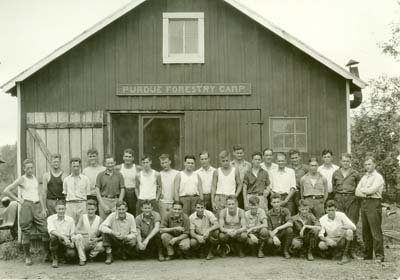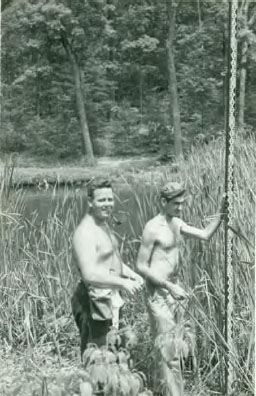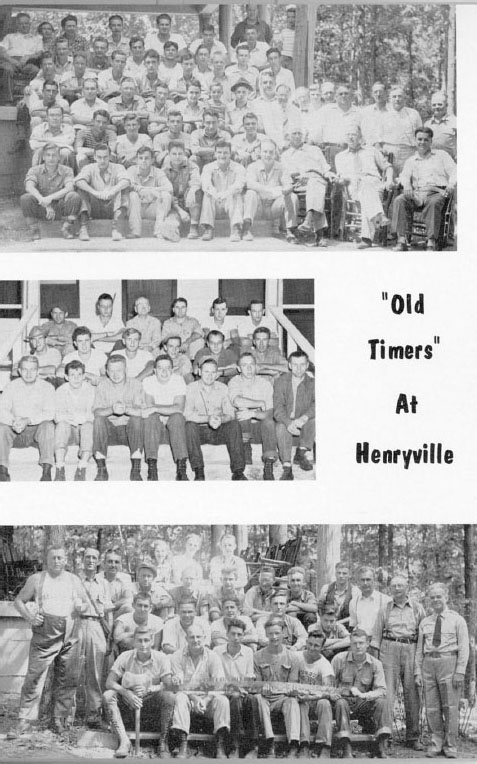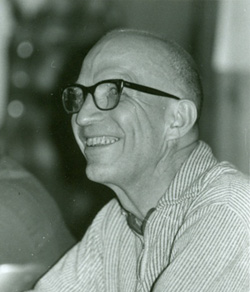Summer Camp: Henryville, Clark State Forest
The first modern Purdue Log, published in 1959, included an article about summer camp. It was motivated no doubt by the fact that 1959 was the year camp moved from Henryville, Indiana to Lost Lake Camp near Tipler, Wisconsin . The article, titled Henryville’s First Rangers, follows in full:

The first Purdue Forestry Camp, held in the summer of 1929, on Clark State Forest, was unique in several respects. The entire Forestry student body was there, ranging from those who had just finished their freshman year to those ready to start their senior year. Current camp staff members probably would claim it to be impossible to teach a group exhibiting such a range in training. Yet it was done, and successfully, with this first group.
Those whose conception of camp life is one of roughing it would have enjoyed this first summer. There was no water supply of any kind at the camp site; water for drinking, cooking and dish washing was hauled in in milk cans. When rains left pools in the usually dry creeks there were opportunities for bathing and doing laundry. Sanitary facilities such as exist today were not even a dream then!
The “old red barn” (which it literally was) provided space for cooking and dining, and also doubled as a study hall. The colored cook claimed to be a meat (fat pork, that is) cook, but the quantities of French toast served by him were such as to satisfy the desires of some of the students for French toast for 25 years afterwards, even though originally they may have considered it a tasty dish. Also, his system of cooking was such that food which could not be fried was considered as hardly fit for human consumption.
 Living quarters consisted of tents erected over wood platforms, each one accommodating two men. Even by standards of those days they were not spacious, having enough space for two bunks and a walkway between. Other than the tents and the red barn the only other “structure” in camp was a canvas fly stretched as a roof over a platform, providing a spot for visiting and loafing in the shade.
Living quarters consisted of tents erected over wood platforms, each one accommodating two men. Even by standards of those days they were not spacious, having enough space for two bunks and a walkway between. Other than the tents and the red barn the only other “structure” in camp was a canvas fly stretched as a roof over a platform, providing a spot for visiting and loafing in the shade.With one student car (a Model T Ford, of course) in camp there was not the evening and week-end exodus which now occurs. Entertainment in camp consisted of a crank-wound phonograph; other than that it was largely what the students could provide themselves.
Twenty-three of the twenty-eight students at camp finished their forestry training. Of these twenty-three, about two-thirds of them still are in forestry or related activities, and at least six of them have taken graduate training to earn M.S. or Ph.D. degrees. An interesting note is that two staff members associated with the first camp have been with the Department ever since; they are “Prof” Prentice and Dan DenUyl.
Since the summer of 1929 nearly 800 students have studied, and taught, and cried, and laughed, and sweat, and learned, and lived, at the Forestry Camp, Henryville, Indiana. But by August 1, 1958, the friendly mess hall, the familiar study hall, the crowded cabins, the humid wash room, and the privies, were boarded up for the last time, and the camp abandoned. But memories of the camp will never die, and for years to come Purdue foresters will talk about when the camp was at Henryville.”
The final Henryville camp had certain things in common with the first camp. The students complained about the food, about poison ivy, and about mice building nests in their clothing, and about being overworked. They also lacked a certain modern convenience. But camp life was not as rough, and not in the least isolated. There was unlimited water, there was electricity throughout the camp, and the students brought nineteen radios, one television, and twenty-three cars to camp. Nor in the final camp did the students survey, and survey, and survey. Instead, they studied forest ecology and forest soils and wrote reports, and wrote reports, and wrote reports.
In 1958 a typical day started at 6:00 A.M. with the ringing of the bell by the student officer of the day. Those men who did not respond to the bell were personally “called” by the O.D. [military reference to officer of the day], or, in some cases the Camp Director. Remember!! After breakfast and the details were completed, the entire group assembled in the study hall. Remember!! After explanations were completed, parties assigned, and equipment issued, it was to the field. For any Purdue forester a few phrases will conjure memories of those days in the field: “D*** it, YOU were supposed to bring the tape!! “Who has the correction factors??” “CHAIN!!! STICK!!! STUCK!!!” “Hurry up, it’s starting to rain!!” “Do I have to go THROUGH that poison ivy??!!” “What Sardines again?!” “Do you have any field splices for the tape?”
The field work ended about 4:45 P.M. Showers, and often a brief nap, preceded dinner at 5:30. For many that hour or so after dinner between twilight and dark was the best part of the day. Some pitched horseshoes, or shot baskets, or played volleyball; others just sat and talked. But when darkness came on, there was studying to do, or a show to attend, or a softball game to play, or . . .
The article closed with a selection from the “The Henryville Saga” by Marcus Hmurovich, class of ’57:
And so with this camp we are done’
And while it hasn’t all been fun,
We do remember with satanic joys
The time that a group of the boys,
Took down the bell and dropped the clapper
Down, Deep, into a convenient ----------------------,
And painted on that famous slogan
To leave behind as a parting token”
In Desperadum
Non Bastatorum
Non Carborundum.”
NOTE:Considering the context a likely translation of the last three lines in Latin is,
Even though I’m in despair and without hope,
I won’t let the b******* weigh me down,
Nor, grind me down.
Click here for all five pages of the complete Henryville Saga from the files of Scott Brundage. Marcus’ translation of the Latin is included.
As the saga indicates training focused on field work, as shown in the photos provided in the Summer Camp Album.
As the Logs for the 1930’s to 1950’s demonstrate, poetry was a major form of self-expression for forestry students at Henryville. Today’s students find this almost impossible to believe. The longest tenure as camp director was held by Charlie Miller. He was either a poet to begin with, or was influenced by the students to become one. He was and most likely will remain the “poet laureate” of the department. No collection of his poems has been located, but examples appear in the Log. This one was published in the 1969 Purdue Log, p. 3, reflects life as a student at summer camp.

Now I lay me down to sleep,
My life may our Director keep.
May this place wherein I dwell
Wind-storm, rain, and bugs repel.
Let no classmate misdirected
Fell a tree where least expected.
May the cooks in making stew
Put in beef that I can chew.
Make my legs strong and limber
For plodding through swamp and timber.
Blank my mind of game preserves
Pellet counts and volume curves.
The sampling block and total heights
Tally sheets and cruiser’s plights.
And when I leave this rough abode
And drive the fearsome forest road
Let my car withstand the jolts
And not lose all its nuts and bolts
Nor waver to the treacherous side
And end up in the flowing tide.
And till dawn replaces night
Make me void of thoughts of flight.
And thanks to him who directs us all,
And guides us through the day’s worst pall.
The Purdue Log 1960, p. 61, included a page titled “ ‘Old Timers’ at Henryville.” Only the three group photos below were included. Apparently these show those attending Henryville Forestry Camp reunions.
A summer camp yearbook was produced by Clement Bryan and his classmates while at Henryville. He was a student from 1933 to 1937. In addition to the “yearbook” provided by his daughter Barbara Bryan Heilers, Houston, OH, she provided photos from his Henryville photo album, which are located in the Summer Camp Album, and his last poem, written several days before he died. Also included were photos of how forestry students dressed on campus, well, at least for special occasions.
Henryville Post-WWII
No summer camp was held from 1942 to 1945 because of WWII. C.I. “Charlie” Miller, Professor Emeritus at the time, wrote “Reminiscences of the Henryville Forestry Camp” for the 1985 Purdue Log. In the article he details the reopening of the camp after WWII. His comparison of Henryville Forestry Camp to a WWII Marine Camp on Guadalcanal were based on Charlie’s service as a Marine Corps officer in the war. Here is his description of Forestry Camp in 1946. –
I joined the Purdue Forestry staff in March 1946. On June 19th of that same year, Professor Al Herrick and I took a work force of six students to the Clark State Forest, Henryville, Indiana, and began cleaning and repairing the Purdue Forestry Camp, which had been mothballed during World War II. With repair work only partially completed, the first post-war camp officially opened on June 23, 1946, with 26 students in attendance. The get-up time was 5:30 with breakfast at 6:00. The work day was from 7:30 to 4:30 five days a week. Camp was a long ten weeks and included three courses: Forest Surveying, cr. 5; Applied Silviculture, cr. 1; Forest Measurements, cr. 4. Insect collecting and industry trips were fitted in here and there to give variety. This program was maintained until 1954.
In 1948 the enrollment was 78 students. (This was the largest camp of the Henryville era.) In this crowded camp the students lived in 10 cabins and 12 tents. The staff, and visitors, lived in three cabins. Both cabins and tents measured 12 by 12 feet.
Although there was electricity in the mess hall, the study hall, and the washroom, the cabins, the tents, and the privies (6 holes) were not wired. In them we used Coleman lanterns. This created a military atmosphere which reminded one of World War II Marine camp on Guadalcanal.
 A memorable character of whom I have fond memories was Entomology Professor B.E. “Monty” Montgomery, a world renowned authority on dragonflies and bees. Monty came to camp for a few days each summer to start students collecting insects for his fall entomology course. During his visit in July 1949, I took him to Bell’s General Store in Henryville to purchase toothpaste and soap. Joby Bell, the owner, waited on us. Since Joby and Monty had never met, I introduced them. Right off, Joby asked, “What do you teach?” Monty thinking that “entomology” might be beyond his vocabulary, replied, “Bugs.” “Well!” exclaimed Joby, “I’ve heard Purdue students called a lot of names, but never that!”
A memorable character of whom I have fond memories was Entomology Professor B.E. “Monty” Montgomery, a world renowned authority on dragonflies and bees. Monty came to camp for a few days each summer to start students collecting insects for his fall entomology course. During his visit in July 1949, I took him to Bell’s General Store in Henryville to purchase toothpaste and soap. Joby Bell, the owner, waited on us. Since Joby and Monty had never met, I introduced them. Right off, Joby asked, “What do you teach?” Monty thinking that “entomology” might be beyond his vocabulary, replied, “Bugs.” “Well!” exclaimed Joby, “I’ve heard Purdue students called a lot of names, but never that!”
But today, gone from the Henryville scene are all the old familiar faces, all the old familiar objects,
“For swiftly o’er the level shore
The waves of progress ride;
Familiar landmarks, one by one,
Shall sink beneath the tide.”
NOTE: Charlie was the department poet, but the closing poem is a verse from D. W. Nash's “The Fox's Prophecy” written in 1870.
Charlie Miller’s files included the text of his last fireside chat at Henryville, as follows:
Farewell to Henryville
I shall commence this evening’s FIRESIDE CHAT by quoting from an article in the July 27th issue of the Louisville Courier-Journal. Said the article; “When Professor C.I. “Charlie” Miller closes the 1958 Purdue University Forestry Camp on August 4, it will mark the end of an era” This then is an appropriate time and place for us to pay homage to Henryville, and to say a final farewell.
To set the stage, and to create the proper mood, I shall first recite parts from that famous work of Marcus Hmurovich alias Captain Lightfoot (class of Jan. 1957, entitled the HENRYVILLE SAGA by Marcus J. Hmurovich, wt. 240 lbs.
After that bit of atmosphere music, let us look back together at some of the characters who have inhabited the Camp. Since the era of the camp extends from 1929 to 1958 there have been lots of them. The conditions under which the camp has been conducted have been conducive to the development of characters. To show you who are unfamiliar with the camp what I mean let me give you a little history.
Let me say I neither condemn nor condone, but like the taxonomist I merely describe and classify.
- The loner – Fleener and Cook. A type we would like fewer of.
- Type that never gets the word – Start at the 10 chain point on the pacing line and traverse the following course. Determine direction with the compass and distance by pacing. Declination 1 degree and 30 minutes East.
N 76° 00’ E for 20 ch.
N 30° 00’ W for 15 ch.
N 83° 30’ W for 15 ch.
S 25° 00’ E for 10 ch.As you traverse the course, record on the map sheet the location of the following features, etc. When you complete the traverse, call for the instructor so he may check your closing point. “Well sonny, if they meant you to finish way over here, they meant to call on the telephone.
- The good Samaritan type.
- The type that gets shook up. Jerry and Yvonne
- The Wayward type – McCarthy
- The type subject to accidents.
- The type that tells non-funny jokes.
Farewell to Clark County
Farewell to the South
Home of the Chigger, tick, and the mouse
Poison ivy indigenous, to torrential rain,
High Abney readins (sic.), and the hill billy dame.
Reminiscences of Summer Camp at Henryville
Crumpacker, D.L., ed. 1932. “1932 Forestry Summer Camp Log.” Unpublished. Donated by Franklin L. “Bumpy” Rhoade. (Includes Introduction by Terence E. Hanley.) 34 p.
Bryon, C.E., ed. 1934. “Purdue Forestry Camp ’34.”Unpublished. Donated by Barbara Bryan Heilers. 34 p.
Bline, D.F. 1936. “Purdue Forestry Camp Log of 36.” Unpublished.
Hall, John. 1947. “Summer Sadness – 1946.” Oak Leaves 1947. Unpublished. p. 28-31.
Prentice, Burr. 1963. “An Early Henryville Emergency Junket.” Purdue Log 1963. p. 14-15.
Geltz, Charles G. and Miller, Charles I. 1965. “The Purdue Forestry Camp.” Purdue Log: Golden Anniversary. p. 29-31.
Anon. 1973. “Looking Back . . .” Purdue Log 1973.p. 26-27.
Anon. 1974. Group photo of Purdue’s first summer camp. Purdue Log 1974. p. 52.
Hanley, Terence. 1999. “Eric Stark and the First Forestry Camp.” The Purdue Log: Anniversary Issue, p. 8-13.